Free Crochet Pattern for a Lacy Crochet Edging in Shell Stitch
Want to learn how to crochet an easy lacy shell edging that’s appropriate for finishing off blankets, tablecloths, dishcloths, potholders, sheets, pillows, placemats, linens and just about any other rectangular, square or straight-across edge you can think of? If so, I am so glad you dropped by! Not only do I have a fantastic free pattern to show you, but I have posted a whole bunch of other free edging patterns — so if this one isn’t quite what you are looking for, you’ll find many other alternatives to choose from. (You can never have too many edging patterns, can you?)
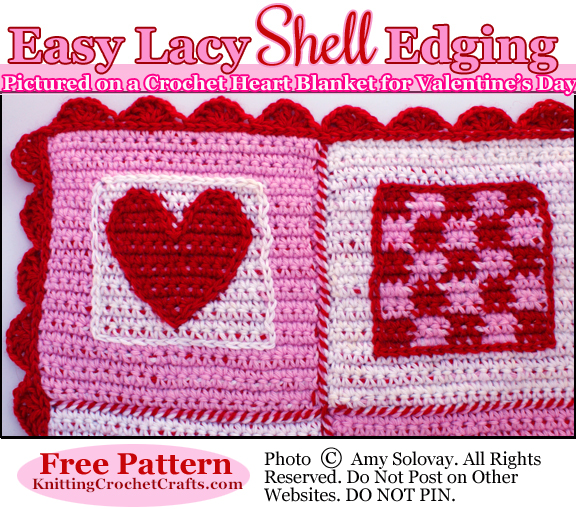
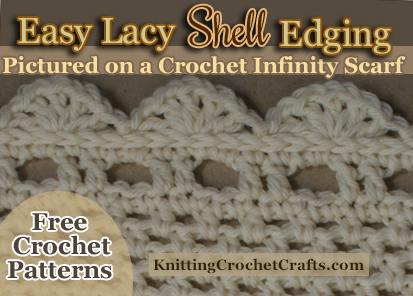
Related Resources: Crochet Lace | Borders, Trims and Edgings | More About Shell Stitch
Get the Companion Patterns to These Designs: Crochet Heart Square | Easy Crochet Infinity Scarf
Skill Level: Beginner
Materials:
Yarn, Thread or Fiber: You can use any suitable yarn, crochet thread or fiber for working this pattern. Ideally, you’ll want to use the same fiber and weight that you used for crocheting the main body of your project. You could either use a different color than the one you used for the main part of the project, or you could use the same color.
In both my sample projects, I used medium weight wool yarn — but it is not necessary for you to duplicate these yarn choices for success with this pattern.
Crochet Hook: Use the same crochet hook you used to complete the main body of your project.
Other: It’s handy to have a tapestry needle for weaving in your ends.
Stitch Multiple
For Projects That Are Square or Rectangular, or Projects Where You Intend to Work Across One Side Only (Not in the Round) — This edging is a multiple of 6 + 1 stitches. For the math to work out right, you’ll need to ensure that your stitch count across each side of the piece is compatible with this stitch multiple.
For Projects Where the Edging is Worked in the Round (Such as Fingerless Gloves, Infinity Scarves, Etc.) — The math may work out better if you stick with a multiple of 6 sts; if you do it this way, when you are ready to work your last sl st, you’ll insert your hook into the first st at the beg of the round.
If you use the 6 + 1 multiple, I think you’d end up with a slight bit of a gap between the end of the round and the beginning. I haven’t double checked this to be sure, so you might want to do the math for yourself both ways on your particular project and ensure that the result would be what you want.
Abbreviations Used in This Pattern:
- ch = chain
- dc = double crochet
- sl st = slip stitch
- st = stitch
How to Crochet the Easy Lacy Shell Edging
Round or Row 1: If you still have an active loop from working your project, and it’s in the right spot for proceeding to work the edging, you can start at that spot. Otherwise, insert your hook into the correct spot and pull up a loop of the color you want to use for crocheting your edging.
(Skip the next 2 sts. In the next st, work a shell as follows: dc, ch 1, dc, ch 1, dc, ch 1, dc, ch 1, dc. Then skip the next 2 chs. Sl st in next st.) Repeat the instructions in parentheses all the way across the side of the project that you are working on.
If you are working across one side only — for example, if you are putting an edging onto a table runner or similar project — you can end off and weave in your end at this point, then skip down to row 2.
Otherwise, when you get to a corner, you don’t have to do anything complicated; just work your final slip stitch into the last stitch before the corner, then work another slip stitch into the first stitch on the other side.
If you crochet really tightly and your tension seems too tight in the corner, you can sneak a slip stitch or two into the corner spot in order to loosen things up. I didn’t find this necessary on my project sample, but it’s an option if you need it.
Round or Row 2: — The objective in this round or row: to work surface crochet slip stitches all the way across or around your piece. You’ll want to work them in the spot where the main body of your project touches row or round 1 that you just crocheted.
If you are working across only one side of a piece, you’re going to need to begin again and get a new active loop started. If you’re right handed, locate the right-hand side of your project and insert your hook into the first stitch to pull up your active loop. If you’re left-handed, locate the left-hand side of your project and insert your hook into the first stitch to pull up your active loop.
Then work your surface crochet slip stitches all the way across. At the end of the row, end off and weave in your loose ends.
If you’re working in rounds all the way around a piece, you will already have an active loop established in the correct spot, and you can proceed to work your surface crochet stitches from that point. At the end of the round, end off and weave in your loose ends.
Enjoy your project!
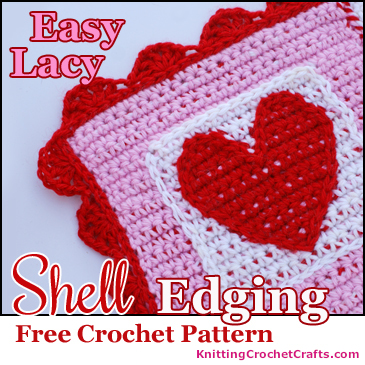
Other Ways to Describe This Easy Lacy Shell Stitch Edging Pattern:
- Easy Lacy Shell Edging Pattern
- free crochet edging pattern,
- crochet shell stitch border pattern,
- crochet shell stitch edging pattern,
- shell stitch trim,
- shell trim,
- shell border
Find More Crochet Patterns and Instructions for Beginners
- Click here to visit our list of beginner crochet patterns.
- Click here to check out our crochet instructions for beginners.
- Click here to find a list of the best crochet books for beginners.
Find More Free Crochet Edging Patterns:
Learn More About Crochet:
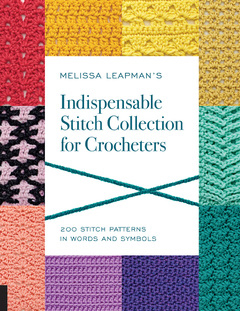
- Click here to find our picks for the best crochet books.
- Click here to find crochet stitch tutorials and instructions.
- Click here to learn more crochet techniques.
- Click HERE to Find Fabulous Yarn for Crochet and Knitting
- Click here to learn about crochet hooks.
- Click here to find my favorite crochet project bag.
Learn About Other Crafts: Knitting, Sewing, Quilting, and More
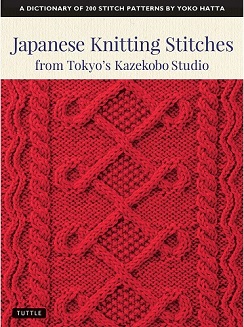
- Click here to get updated on the latest craft supplies.
- Click here to learn about knitting.
- Click here to find our beginner’s guide to knitting needles.
- Click here to find outstanding craft project ideas.
Posted By: Amy Solovay
Page last updated on 8-17-2023. Thanks for visiting!